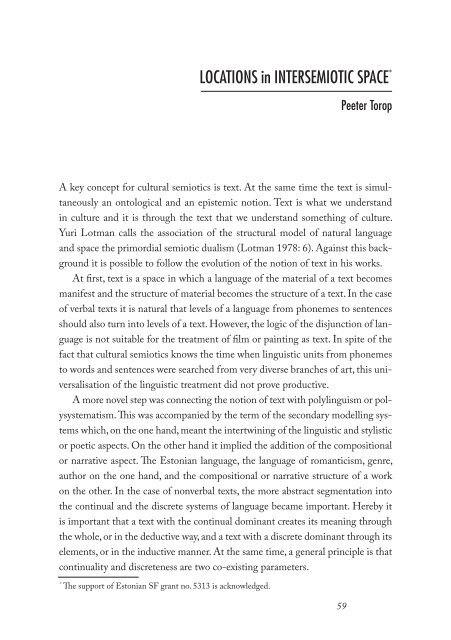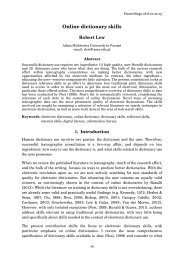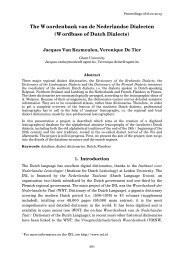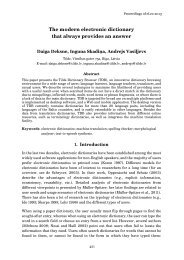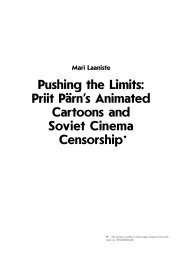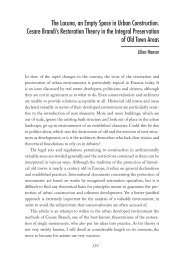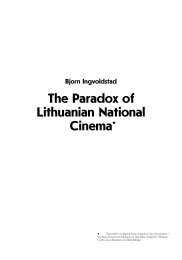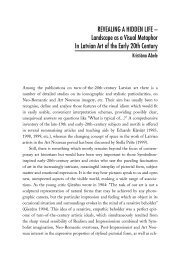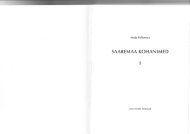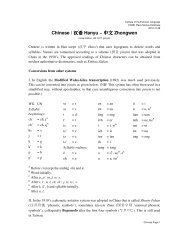LOCATIONS in INTERSEMIOTIC SPACE*
LOCATIONS in INTERSEMIOTIC SPACE*
LOCATIONS in INTERSEMIOTIC SPACE*
You also want an ePaper? Increase the reach of your titles
YUMPU automatically turns print PDFs into web optimized ePapers that Google loves.
A key concept for cultural semiotics is text. At the same time the text is simul-<br />
taneously an ontological and an epistemic notion. Text is what we understand<br />
<strong>in</strong> culture and it is through the text that we understand someth<strong>in</strong>g of culture.<br />
Yuri Lotman calls the association of the structural model of natural language<br />
and space the primordial semiotic dualism (Lotman 1978: 6). Aga<strong>in</strong>st this back-<br />
ground it is possible to follow the evolution of the notion of text <strong>in</strong> his works.<br />
At first, text is a space <strong>in</strong> which a language of the material of a text becomes<br />
manifest and the structure of material becomes the structure of a text. In the case<br />
of verbal texts it is natural that levels of a language from phonemes to sentences<br />
should also turn <strong>in</strong>to levels of a text. However, the logic of the disjunction of lan-<br />
guage is not suitable for the treatment of film or pa<strong>in</strong>t<strong>in</strong>g as text. In spite of the<br />
fact that cultural semiotics knows the time when l<strong>in</strong>guistic units from phonemes<br />
to words and sentences were searched from very diverse branches of art, this uni-<br />
versalisation of the l<strong>in</strong>guistic treatment did not prove productive.<br />
A more novel step was connect<strong>in</strong>g the notion of text with polyl<strong>in</strong>guism or pol-<br />
ysystematism. is was accompanied by the term of the secondary modell<strong>in</strong>g sys-<br />
tems which, on the one hand, meant the <strong>in</strong>tertw<strong>in</strong><strong>in</strong>g of the l<strong>in</strong>guistic and stylistic<br />
or poetic aspects. On the other hand it implied the addition of the compositional<br />
or narrative aspect. e Estonian language, the language of romanticism, genre,<br />
author on the one hand, and the compositional or narrative structure of a work<br />
on the other. In the case of nonverbal texts, the more abstract segmentation <strong>in</strong>to<br />
the cont<strong>in</strong>ual and the discrete systems of language became important. Hereby it<br />
is important that a text with the cont<strong>in</strong>ual dom<strong>in</strong>ant creates its mean<strong>in</strong>g through<br />
the whole, or <strong>in</strong> the deductive way, and a text with a discrete dom<strong>in</strong>ant through its<br />
elements, or <strong>in</strong> the <strong>in</strong>ductive manner. At the same time, a general pr<strong>in</strong>ciple is that<br />
cont<strong>in</strong>uality and discreteness are two co-exist<strong>in</strong>g parameters.<br />
* e support of Estonian SF grant no. 5313 is acknowledged.<br />
<strong>LOCATIONS</strong> <strong>in</strong> <strong>INTERSEMIOTIC</strong> SPACE *<br />
Peeter Torop<br />
59
Peeter Torop<br />
As the third stage, we can name the treatment of text as a mechanism gener-<br />
at<strong>in</strong>g language i.e., as a dialogic whole. Lotman consciously replaced the notion<br />
of reception with the term of communication, and thus <strong>in</strong>sisted upon the dialogic<br />
activity of text. At the meet<strong>in</strong>g of a text with the addressee there can appear sev-<br />
eral communicative levels, simultaneously or separately: text as a message means<br />
communication between the addressee and the addressant, text as a bearer of the<br />
collective cultural memory means communication between the cultural tradition<br />
and the audience, text as a mediator <strong>in</strong>fluenc<strong>in</strong>g the shap<strong>in</strong>g of personality means<br />
communication of the reader with him/herself, text as an <strong>in</strong>dependent <strong>in</strong>tellec-<br />
tual conglomeration and an autonomous dialogue partner means communication<br />
of the reader with the text, and text as a full-value partner <strong>in</strong> a communication act<br />
means communication between the text and cultural context (Lotman 1981: 6).<br />
In the case of dialogical treatment of text, space has changed – the textual<br />
space has turned <strong>in</strong>to a cultural space, and the text as an artefact produced from a<br />
material, has become a cultural text. is change has been put <strong>in</strong>to written form<br />
already <strong>in</strong> the theses of the Tartu-Moscow cultural semiotics (1973): ‘In def<strong>in</strong><strong>in</strong>g<br />
culture as a certa<strong>in</strong> secondary language, we <strong>in</strong>troduce the concept of a ‘culture<br />
text’, a text <strong>in</strong> this secondary language. So long as some natural language is a part<br />
of the language of culture, there arises the question of the relationship between<br />
the text <strong>in</strong> the natural language and the verbal text of culture.’ (eses 1973: 43.)<br />
e eses of 1973 are also important with regard to the relation between parts<br />
and the whole: ‘e relationship of the text with the whole of culture and with<br />
its systems of codes is shown by the fact,that on different levels the same message<br />
may appear as a text, part of a text, or an entire set of texts.’ (eses 1973: 38.)<br />
Yuri Lotman’s evolution cont<strong>in</strong>ues clearly homologously towards the notion<br />
of the semiosphere. First, semiosphere establishes the dynamics between the part<br />
and the whole: ‘S<strong>in</strong>ce all the levels of the semiosphere – rang<strong>in</strong>g from a human<br />
<strong>in</strong>dividual or an <strong>in</strong>dividual text to global semiotic unities – are all like semio-<br />
spheres <strong>in</strong>serted <strong>in</strong>to each other, then each and one of them is both a participant<br />
<strong>in</strong> the dialogue (a part of the semiosphere) as well as the space of the dialogue (an<br />
entire semiosphere).’ (Lotman 1984: 22.) Second, this whole–part relationship is<br />
jo<strong>in</strong>ed, <strong>in</strong> turn, by the dynamics between the subjective and objective: ‘e struc-<br />
tural parallelism between semiotic characteristics of a text and of a personality<br />
enables us to def<strong>in</strong>e any text on any level as a semiotic personality, and to regard<br />
any personality on any sociocultural level as a text.’ (Lotman 1992: 116.)<br />
60
Locations <strong>in</strong> Intersemiotic Space<br />
However, <strong>in</strong> the conception of the semiosphere, the dimension of time is<br />
far more important. One of the founders of the Tartu-Moscow semiotic school,<br />
Vjatsheslav Ivanov, has created the historiosophic dimension for the whole semi-<br />
otics through the use of the notion of semiosphere: ‘e task of semiotics is to<br />
describe the semiosphere without which the noosphere is <strong>in</strong>conceivable. Semiot-<br />
ics has to help us <strong>in</strong> orient<strong>in</strong>g <strong>in</strong> history. e jo<strong>in</strong>t effort of all those who have<br />
been active <strong>in</strong> this science or the whole cycle of sciences must contribute to the<br />
ultimate future establishment of semiotics.’ (Ivanov 1998: 792.) Still, Lotman<br />
locates himself <strong>in</strong> the context of semiology and expla<strong>in</strong>s, <strong>in</strong> connection with the<br />
notion of time, relationships between diachrony and synchrony. In his book Uni-<br />
verse of the M<strong>in</strong>d (1990) he has claimed that synchrony is homeostatic and that<br />
diachrony is a sequence of external and accidental disturbances, react<strong>in</strong>g to which<br />
synchrony restores its <strong>in</strong>tegral wholeness (Lotman 1990: 6).<br />
e rapid and primarily technological development of the cultural environ-<br />
ment has brought along change <strong>in</strong> the ontological boundaries of texts. is,<br />
<strong>in</strong> turn, is a challenge for analysts. Let us, for example, consider a children’s<br />
story-book that conta<strong>in</strong>s, <strong>in</strong> addition to a fairy tale, lots of <strong>in</strong>formation, rang<strong>in</strong>g<br />
from dictionary to encyclopaedia, and also pictures and photographs. All this is<br />
presented to contemporary children <strong>in</strong> hypertextual design. Pr<strong>in</strong>ted media has<br />
become close to hypermedia, and forces the reader to make l<strong>in</strong>ks <strong>in</strong> addition to<br />
l<strong>in</strong>ear movement. As a second example, let us take a film on DVD that conta<strong>in</strong>s<br />
a longer version of a film than VHS, added by episodes left out from the f<strong>in</strong>al<br />
version, the trailer, <strong>in</strong>terview with the director, and a documentary about the<br />
mak<strong>in</strong>g of the film.<br />
e juvenile book is an example of a metacommunicative whole <strong>in</strong> which<br />
the prototext is supplemented by a range of verbal and visual metatexts. While<br />
<strong>in</strong> culture the metacommunicative connections of a s<strong>in</strong>gle prototext are usually<br />
separated and they are connected by time, or collective cultural memory, then <strong>in</strong><br />
the book as a cultural text it is possible to create coherence <strong>in</strong> terms of space and<br />
time. In the case of the film, however, several important aspects are raised.<br />
e first one connects to the topic of prototext, s<strong>in</strong>ce under the same title<br />
there can exist several versions, and we do not know if the orig<strong>in</strong>al is <strong>in</strong> the shape<br />
of a movie, VHS, or DVD. We can analyse this as a str<strong>in</strong>g rather as a process, for<br />
the temporal sequence has been set. e second aspect is related to the creation<br />
process and bluepr<strong>in</strong>ts. In culture there has appeared the fusion of the processes<br />
61
Peeter Torop<br />
of reception and creation. A bluepr<strong>in</strong>t or a fragment of a work not yet completed<br />
is consciously brought to the addressee <strong>in</strong> the market<strong>in</strong>g process or as a pre-ad-<br />
vert. What earlier used to belong to the sphere of textology or the reconstruction<br />
of the creative process, is now part of the function<strong>in</strong>g of the text <strong>in</strong> culture. Text<br />
therefore locates <strong>in</strong>to a wide <strong>in</strong>tersemiotic space, and the analysis of it demands<br />
complex <strong>in</strong>spection of its creation, construction, and reception. us a text is a<br />
process <strong>in</strong> <strong>in</strong>tersemiotic space.<br />
A process tak<strong>in</strong>g place <strong>in</strong> <strong>in</strong>tersemiotic space can be compared to a textologist<br />
who tries to sense, through notes, bluepr<strong>in</strong>ts and versions, the work<strong>in</strong>g of the<br />
writer’s m<strong>in</strong>d and the story of the creation of his work. In the case of literature we<br />
can talk about the macrotime of the manuscript and the microtime of a concrete<br />
page of the manuscript. e macrotime of the manuscript is first related with the<br />
possibility to create a complete diachronic str<strong>in</strong>g, i.e. to arrange all the materials<br />
of the manuscript chronologically. Second, <strong>in</strong> the case of the impossibility of re-<br />
construct<strong>in</strong>g the diachronic str<strong>in</strong>g, all the material can be divided <strong>in</strong>to the stages<br />
or periods of the creation of a work or the realisation of an <strong>in</strong>tention. is means<br />
that concrete time is replaced by an <strong>in</strong>terval <strong>in</strong> the frame of which the material<br />
is arranged accord<strong>in</strong>g to the psychosemantic pr<strong>in</strong>ciple, i.e., <strong>in</strong> accordance with a<br />
vision of the given creative process. e microtime first relates to the sequence<br />
of the fill<strong>in</strong>g of a concrete page of the manuscript as a holistic unit of the manu-<br />
script. Second, microtime connects to the psychosemantic sens<strong>in</strong>g of the fill<strong>in</strong>g<br />
sequence of this page; dur<strong>in</strong>g this every s<strong>in</strong>gle entry becomes a m<strong>in</strong>imal unit.<br />
In this case the importance of relations between different entries on the same<br />
time is replaced by the importance of the psychosemantic connection between<br />
repetitive entries of a certa<strong>in</strong> type that l<strong>in</strong>k up different pages of the manuscript.<br />
In addition to the macro- and microtime of the manuscript there is also reason<br />
to dist<strong>in</strong>guish the achrony of the manuscript, which means the understand<strong>in</strong>g of<br />
the manuscript as an archive document <strong>in</strong> which the m<strong>in</strong>imal unit is formed by<br />
the whole manuscript or its holistic part as a fascicle, notebook or the like.<br />
us any text is, on the one hand the result of a creative process, and a start-<br />
<strong>in</strong>g po<strong>in</strong>t of the reception process, on the other. Br<strong>in</strong>g<strong>in</strong>g the creative process<br />
and bluepr<strong>in</strong>ts <strong>in</strong>to theoretical discussion seems to be necessary <strong>in</strong> spite of the<br />
fact that dur<strong>in</strong>g the age of computers the ord<strong>in</strong>ary bluepr<strong>in</strong>t has changed. Ossip<br />
Mandelstam, the Russian poet and th<strong>in</strong>ker, has written about the permanence of<br />
62
Locations <strong>in</strong> Intersemiotic Space<br />
the bluepr<strong>in</strong>t: ‘Bluepr<strong>in</strong>ts never perish. In poetry, plastics, and art <strong>in</strong> general there<br />
are no completed th<strong>in</strong>gs ... us the permanence of the bluepr<strong>in</strong>t is the law of<br />
conservation of the energy of the work.’ (Mandelstam 1967: 27–28.) e study of<br />
the bluepr<strong>in</strong>t, like the conscious br<strong>in</strong>g<strong>in</strong>g of the bluepr<strong>in</strong>t <strong>in</strong>to culture <strong>in</strong>creases<br />
teleology <strong>in</strong> the creative process. A bluepr<strong>in</strong>t researcher is usually familiar with<br />
the f<strong>in</strong>al text and can, through bluepr<strong>in</strong>ts, follow the generation of the text both<br />
on the level of diverse sign systems and as the emergence of a conceptual whole.<br />
Bluepr<strong>in</strong>t is like culture. In bluepr<strong>in</strong>t we can dist<strong>in</strong>guish the complementarity<br />
of sign systems <strong>in</strong> the creative process, follow the shap<strong>in</strong>g of an <strong>in</strong>tention <strong>in</strong>to<br />
a conceptual work of art, analyse the world of thought of the creator and his<br />
location <strong>in</strong> the <strong>in</strong>tertextual space. For example, Fyodor Dostoyevsky’s notebooks<br />
conta<strong>in</strong> ideas, pictures, bluepr<strong>in</strong>ts of others, but alongside them also details of at-<br />
tacks of epilepsy, facts connected with housekeep<strong>in</strong>g, and also social and political<br />
thoughts. Be<strong>in</strong>g a notebook belong<strong>in</strong>g to the pre-material of a novel, it conta<strong>in</strong>s a<br />
lot of <strong>in</strong>formation that is seem<strong>in</strong>gly of secondary importance, though belong<strong>in</strong>g<br />
to the same era. e result of complex study of a bluepr<strong>in</strong>t is the peculiarity of<br />
the creation process, and together with that, understand<strong>in</strong>g the specific nature of<br />
the f<strong>in</strong>al text. Analysis of the creative process is holistic by nature, s<strong>in</strong>ce the f<strong>in</strong>al<br />
result is already known.<br />
Whereas, if we start from the already created text that switches <strong>in</strong>to the <strong>in</strong>-<br />
tersemiotic space of culture it, as a prototext, becomes a foundation for an <strong>in</strong>f<strong>in</strong>ite<br />
number of metatexts; it creates <strong>in</strong>tertextual and other connections and loses its<br />
ontological boundaries <strong>in</strong> the end. In culture, text becomes a diffused mental<br />
whole. Evaluat<strong>in</strong>g a text from the side of reception we can, on the one hand, es-<br />
timate the translatability of a text <strong>in</strong>to other texts and <strong>in</strong>to other sign systems by<br />
the comparison of the prototext and metatext. Whereas we can study the recep-<br />
tion process as a whole, the orig<strong>in</strong>al prototext turns, <strong>in</strong> its essence, <strong>in</strong>to an arche-<br />
metatext, i.e., <strong>in</strong>to a non-exist<strong>in</strong>g text that is reconstructible through metatexts.<br />
Non-existence or <strong>in</strong>visibility means that the reception is formed of a range of<br />
events and the study of them can lead us quite far from the actual nature of the<br />
text. Michael Riffaterre was afraid of exactly that when he opposed <strong>in</strong>tertextual-<br />
ity to hypertextuality. Accord<strong>in</strong>g to his logic, the study of <strong>in</strong>tertextual relations is<br />
yet the study of a conceptual whole. In his op<strong>in</strong>ion the text itself creates the rules<br />
of <strong>in</strong>tertextuality that are applicable to it. At the same time Riffaterre is afraid<br />
of hypertextuality exactly because of the diffusion of the nature of a text, and of<br />
63
Peeter Torop<br />
the replacement of the study of regular connections with the study of occasional<br />
connections (Riffaterre 1994: 779–788). On the other hand, these casualties are<br />
exactly those dialogical events that base Mikhail Bakht<strong>in</strong>’s conception of culture,<br />
or on the grounds of which Umberto Eco has written, aside with decod<strong>in</strong>g <strong>in</strong><br />
culture, about extracod<strong>in</strong>g <strong>in</strong> its two manifestations – under- and overcod<strong>in</strong>g<br />
(Eco 1977: 136).<br />
One th<strong>in</strong>g is culture’s actual function<strong>in</strong>g and diversity <strong>in</strong> the reception proc-<br />
esses. Another th<strong>in</strong>g is an analyst’s <strong>in</strong>terest <strong>in</strong> the fate of a text as an artistic whole<br />
<strong>in</strong> culture, and <strong>in</strong> the comparison of the immanent peculiarity of a text with the<br />
text as a cultural text or the peculiarity of a text accepted <strong>in</strong>to culture. e accept-<br />
<strong>in</strong>g of a text <strong>in</strong>to culture and the creation of a text are both autocommunicative<br />
processes. e autocommunicativeness of culture is not much different from the<br />
autocommunicativeness of an <strong>in</strong>dividual creator. In neither case do we know with<br />
certa<strong>in</strong>ty if the case is about mnemonic autocommunication, i.e., about report<strong>in</strong>g<br />
the already known <strong>in</strong> another form or other sign systems, or with discover<strong>in</strong>g<br />
autocommunication, i.e., with the creation of novel correlations <strong>in</strong> what exists <strong>in</strong><br />
memory.<br />
Both autocommunicative processes are also <strong>in</strong>tegrative. An <strong>in</strong>dividual author<br />
<strong>in</strong>tegrates bluepr<strong>in</strong>ts <strong>in</strong>to a f<strong>in</strong>al text. Culture <strong>in</strong>tegrates metatexts <strong>in</strong>to a mental<br />
whole. In culture, from Yuri Lotman’s viewpo<strong>in</strong>t, we can dist<strong>in</strong>guish between two<br />
types of <strong>in</strong>tegration. One of them is connected with the development of meta-<br />
languages, i.e., with the meta- and autometadescriptions <strong>in</strong> culture. e other is<br />
connected with creolisation, i.e., with the fusion of the object- and metalanguag-<br />
es (Lotman 1978). us it is not enough to limit ourselves to a mental whole.<br />
Another parameter is needed still – the <strong>in</strong>tersemiotic one.<br />
e <strong>in</strong>tersemiosic aspect of culture is due to the partial overlap of signs and<br />
languages or sign systems of different arts – first, on the level of <strong>in</strong>dependent<br />
existence of these languages and texts created <strong>in</strong> them (e.g. film and theatre). e<br />
existence of a text as different simultaneous texts (e.g. novel, film, performance,<br />
picture) on the level of mental <strong>in</strong>terference is the second. e third: the level of<br />
projection to the propositional textual or <strong>in</strong>tertextual background. At the <strong>in</strong>-<br />
tersemiosic description of culture the recognisability of signs becomes important<br />
and also the fact that this recognisability takes place not only <strong>in</strong> the reception<br />
of <strong>in</strong>dividual holistic texts, but also <strong>in</strong> fragmentary reception processes. In the<br />
<strong>in</strong>tersemiosis of culture, mak<strong>in</strong>g sense and the hierarchisation of signs does not<br />
64
Locations <strong>in</strong> Intersemiotic Space<br />
depend merely on texts — the same signs can belong to different texts and sign<br />
systems, and possess different mean<strong>in</strong>gs <strong>in</strong> different systems. Understand<strong>in</strong>g<br />
cultural perception mechanisms is the basis for the understand<strong>in</strong>g of the <strong>in</strong>ter-<br />
l<strong>in</strong>gual, <strong>in</strong>tertextuality, <strong>in</strong>terdiscursivity, and <strong>in</strong>termediality; thus the ontology of<br />
signs of different cultural texts is based on the nature of <strong>in</strong>tersemiosis.<br />
e result comes <strong>in</strong> the need for a functional classification of signs outside the<br />
classification of types of signs. For the purposes of recognisability, it is useful to<br />
dist<strong>in</strong>guish a priori or generally known signs, processual or authorship signs that<br />
bear a conception and are often of an ad hoc nature, and a posteriori signs, i.e.,<br />
signs mak<strong>in</strong>g sense of the text as a whole. e functional aspect enables cultural<br />
autocommunicative sign processes and transformations to be followed, e.g. the<br />
translation of processual or authorship signs <strong>in</strong>to a priori or conventional signs.<br />
is goes both for the translation of a verbal sign <strong>in</strong>to another verbal sign, and<br />
the translation of a verbal sign <strong>in</strong>to a visual or audiovisual.<br />
e peculiarity of an <strong>in</strong>tersemiotic space is, <strong>in</strong>deed, both multiple read<strong>in</strong>g and<br />
multiple <strong>in</strong>terpretation carried out simultaneously through the help of different<br />
sign systems. Re-read<strong>in</strong>g and <strong>in</strong>terpretation <strong>in</strong> the <strong>in</strong>tersemiotic space is com-<br />
parable to Roman Jakobson’s description of <strong>in</strong>tersemiotic translation ( Jakobson<br />
1992). However, the simultaneity of translation processes <strong>in</strong> culture raises, on the<br />
one hand, questions about the perceptual unity of the translation of a concrete<br />
<strong>in</strong>tersemiotic translation and, on the other hand, the perceptual vagueness as a<br />
result of the fusion of transformations <strong>in</strong> culture. On the level of both a s<strong>in</strong>gle<br />
text or its transformation, and all possible transformations, there is reason to<br />
remember the words of Nelson Goodman: ‘Conception without perception is<br />
empty, perception without conception is bl<strong>in</strong>d.’ (Goodman 1978: 6.) Conceptu-<br />
alisation, de- and reconceptualisation <strong>in</strong> culture are equally probable and depend<br />
on the peculiarity of the processes of cultural autocommunicative processes, i.e.,<br />
on how texts, types of texts and their transformations are understood.<br />
Practical analysis of cultural texts, their <strong>in</strong>tersemiotic nature as simultaneous<br />
existence as transformations <strong>in</strong> different sign systems raises the need to br<strong>in</strong>g<br />
together two problems. One of them is the analysability of a text taken <strong>in</strong>dividu-<br />
ally, and the second is the analysability of a text located <strong>in</strong> <strong>in</strong>tersemiotic space.<br />
is, <strong>in</strong> turn, raises an important methodological problem about those immanent<br />
parameters of a text that are connected with material and composition, and about<br />
the universal parameters – such as the chronotope – that are <strong>in</strong>dependent of the<br />
65
Peeter Torop<br />
material of the text and apply to text expressed <strong>in</strong> different sign systems. Chro-<br />
notopic analysis allows us to connect the analysis of a s<strong>in</strong>gle text with textual<br />
analysis <strong>in</strong> <strong>in</strong>tersemiotic space. is, however, is an <strong>in</strong>dependent topic.<br />
A part of culture analysis has also been the development of concepts. e text as a<br />
key notion for cultural semiotics is also <strong>in</strong> need of refreshment. e notion of text<br />
needs to be made more precise <strong>in</strong> accordance with its location <strong>in</strong> culture. Text as<br />
a bordered, structural and coherent whole is only an elementary notion. e term<br />
of the cultural text is more dynamic and <strong>in</strong>volves both the possibility of a text to<br />
be a part of culture, and culture’s possibility to be a text or to be described as a<br />
text. Cultural text is certa<strong>in</strong>ly also a communicative notion. Description becomes<br />
more complex when approached from the perspective of metacommunication. A<br />
new parameter is mental text, or the notion of a text as a prototext with metatexts<br />
rooted <strong>in</strong> it that actualises as a mnemonic picture, and the peculiarity of which<br />
depends on the hierarchy of communication channels <strong>in</strong> culture. Mental text is<br />
not easily analysable as assembled text <strong>in</strong> the collective or <strong>in</strong>dividual memory. e<br />
same metacommunicative situation can also be described as a complementary<br />
text <strong>in</strong> which there is the coexistence of a text and metatexts of different types<br />
either <strong>in</strong>side the text (comments, illustrations, foreword, etc.) or outside it (criti-<br />
cism, advertisement, parody, stag<strong>in</strong>g, etc.). In addition to relations between text<br />
and metatext, description can be based on the complementary nature of percep-<br />
tion processes that allows us to talk about the multimodal text. If multimodality<br />
sways outside the text, i.e., when text is realised <strong>in</strong> a different material, we can<br />
talk about the multimedial text (e.g. multimedial commentary on a book).<br />
Creole text can be an umbrella-term for texts that demolish the traditional<br />
boundaries of the text. is is a notion that signifies <strong>in</strong>terference <strong>in</strong> textual crea-<br />
tion, the mix<strong>in</strong>g of sign systems and channels, the annihilation of the ord<strong>in</strong>ary<br />
boundaries of the text. is can be the c<strong>in</strong>egratography as the meet<strong>in</strong>g of graphic<br />
and photographic trends <strong>in</strong> computer animation. It can be a book on CD-ROM<br />
or DVD <strong>in</strong> which verbal text is supported by sound and mov<strong>in</strong>g picture. It can<br />
be hypertextual text, for example, the writ<strong>in</strong>g of collective texts. It can also be the<br />
chang<strong>in</strong>g of an ord<strong>in</strong>ary book <strong>in</strong>to a heterogeneous text through the assembly of<br />
diverse <strong>in</strong>formation or the deconstruction of the beg<strong>in</strong>n<strong>in</strong>g and/or the end (e.g.<br />
Boris Akun<strong>in</strong>’s experiment with the book beg<strong>in</strong>n<strong>in</strong>g from both sides).<br />
With the help of these diverse notions we can describe the different loca-<br />
66
Locations <strong>in</strong> Intersemiotic Space<br />
tions of texts both <strong>in</strong> cultural space and <strong>in</strong> cultural processes. Creole text as an<br />
umbrella-term <strong>in</strong> this l<strong>in</strong>e signifies an important aspect of cultural dynamics.<br />
Yuri Lotman has viewed the creolisation of cultural languages alongside with<br />
the specialisation of cultural languages and has stressed that creolisation is but<br />
a temporary stage at the transfer to new specialisation (Lotman 1978: 10). us<br />
the notion of creole text is a conditional mark for the type of texts that seem to<br />
be heterogeneous at one historical moment, and have already been accepted as a<br />
new homogeneity at another moment. is is due to the fact that heterogeneity<br />
and homogeneity depend upon the development of the cultural environment<br />
and also on technological renewal. us the feature of creole text is a sphere of<br />
cultural creation.<br />
Conclusion<br />
Bluepr<strong>in</strong>t is a perceptual and mental whole that reflects the creation process and<br />
casts some light on the secrets of creation, for the end result is already known.<br />
Text <strong>in</strong> cultural metacommunication is also a mental whole, but ambivalent per-<br />
ceptually and creative of mental fragmentar<strong>in</strong>ess. Creole text is an attempt to<br />
create new ontologies of texts, and <strong>in</strong> this cultural creative th<strong>in</strong>k<strong>in</strong>g becomes evi-<br />
dent, even though we are not familiar with the f<strong>in</strong>al text. us, <strong>in</strong> contemporary<br />
culture it is worth remember<strong>in</strong>g classical textology and, where possible, apply<strong>in</strong>g<br />
this to the processual and at the same time holistic description of culture. Indeed,<br />
I would like to stress that <strong>in</strong> today’s cultural processes there is much that allows<br />
us to ma<strong>in</strong>ta<strong>in</strong> that culture is a bluepr<strong>in</strong>t and analysable as a draft. is br<strong>in</strong>gs<br />
back the teleological dimension of culture analysis and allows us to describe and<br />
make sense of the location of texts <strong>in</strong> culture, as well as their location <strong>in</strong> the <strong>in</strong>-<br />
tersemiotic cultural space and simultaneously <strong>in</strong> the creative process of culture.<br />
References<br />
E c o, Umberto 1977. A eory of Semiotics. London, Bas<strong>in</strong>gstoke: e Macmillan Press<br />
G o o d m a n, Nelson 1978. Ways of Worldmak<strong>in</strong>g. Hassocks: e Harvester Press<br />
I v a n o v 1998 = Вячеслав В. Иванов. Избранные труды по семиотике и истории<br />
культуры. Москва: Языки славянской культуры<br />
J a k o b s o n, Roman 1992. On l<strong>in</strong>guistic aspects of translation. – R. Jakobson, Selected<br />
Writ<strong>in</strong>gs II. Word and Language. e Hague, Paris: Mouton de Gruyter, pp. 260–266<br />
67
Peeter Torop<br />
L o t m a n 1978 = Юрий М. Лотман. Феномен культуры. – Sign Systems Studies, Vol.<br />
10, pp. 3–17<br />
L o t m a n 1981 = Юрий М. Лотман. Семиотика культуры и понятие текста. – Sign<br />
Systems Studies, Vol. 12, pp. 3–7<br />
L o t m a n 1984 = Юрий М. Лотман. О семиосфере. – Sign Systems studies, Vol. 17,<br />
pp. 5–23<br />
L o t m a n, Yuri 1990. Universe of the M<strong>in</strong>d: A Semiotic eory of Culture. London, New<br />
York: I. B. Tauris<br />
L o t m a n 1992 = Юрий М. Лотман. К построению теории взаимодействия<br />
культур (семиотический аспект). – Ю. М. Лотман. Избранные статьи в<br />
трех томах. Том I. Статьи по семиотике и типологии культуры. Таллинн:<br />
Александра, pp. 110–120<br />
M a n d e l s t a m 1967 = Осип Э. Мандельштам. Разговор о Данте. Москва:<br />
Советский писатель<br />
R i f f a t e r r e, Michael 1994. Intertextuality vs. hypertextuality. – New Literary History,<br />
Vol. 25, pp. 779–788<br />
T h e s e s 1973 = В. В. Иванов, Ю. М. Лотман, А. М. Пятигорски, В. Н. Топоров,<br />
Б. А. Успенски. Тезисы к семиотическому изучению культур (в применении к<br />
славянским текстам). – Studia poświęcone VII Miçdzynarodowemu kongresowi slawistów.<br />
Warszawa, Wroclaw, pp. 337–355<br />
68


